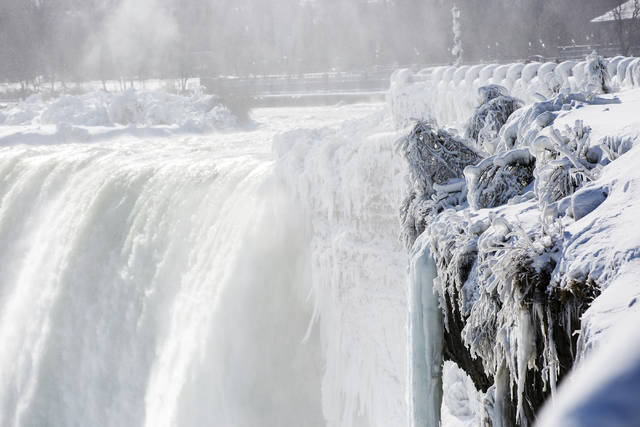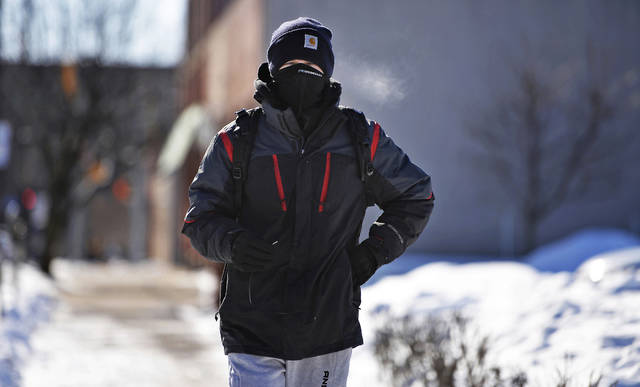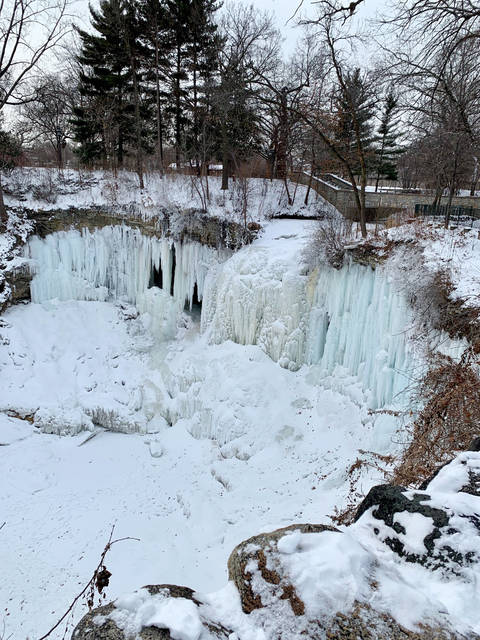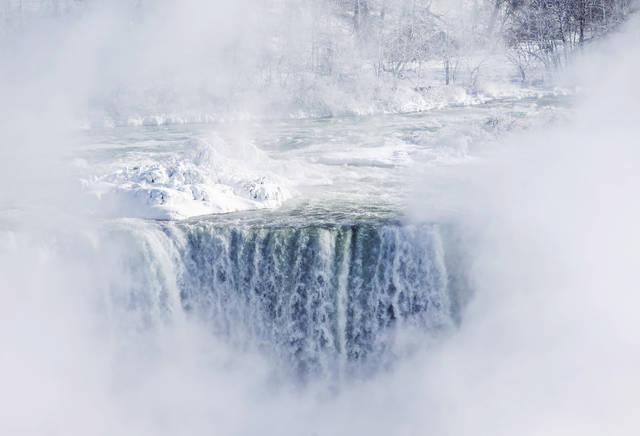CHICAGO — In Illinois, temperatures could rise by 80 degrees within days. In Michigan, melting snow and rain and a 17-mile ice jam on the Muskegon River could lead to flooding. And across the Midwest, the warmer forecast was sure to bring more broken roads and busted water mains.
The polar vortex that brought many cities to a standstill was expected to come to a swift end with a rapid thaw that experts say could be unprecedented. But the sudden swing from long johns to short sleeves could create problems of its own.
“I don’t think there’s ever been a case where we’ve seen (such a big) shift in temperatures,” in the winter, said Jeff Masters, meteorology director of the Weather Underground firm. “Past record-cold waves have not dissipated this quickly. … Here we are going right into spring-like temperatures.”
On Thursday, the system marched east, spreading arctic conditions over an area spanning from Buffalo to Brooklyn. In western New York, a storm that dumped up to 20 inches of snow (51 centimeters) gave way to subzero temperatures and face-stinging wind chills. In New York City, about 200 firefighters battling a blaze in a commercial building took turns getting warm on buses. The number of deaths that could be blamed on the cold climbed to at least 15.
For the nation’s midsection, relief was as close as the weekend.
Rockford, Illinois, was at a record-breaking minus 31 (minus 35 Celsius) on Thursday morning but should be around 50 (10 Celsius) on Monday. Other previously frozen areas could see temperatures 55 degrees or higher.
The dramatic warm-up will offer a respite from the bone-chilling cold that canceled schools, closed businesses and halted trains. But potholes will appear on roads and bridges weakened by the freeze-thaw cycle. The same cycle can crack water mains and homeowners’ pipes. Scores of vehicles will be left with flat tires and bent rims.
Joe Buck, who manages Schmit Towing in Minneapolis and spent about 20 hours a day outdoors this week responding to stranded vehicle calls, said he’s already taking calls for Monday to deal with a backlog of hundreds of stalled vehicles.
“Sunday is going to be 39 degrees ABOVE zero,” said Buck, who has had 18 trucks running around the clock in wind chills that dropped to minus 50.
In Detroit, where some water mains are almost 150 years old, city workers were dealing with dozens of breaks, said Palencia Mobley, deputy director of the Detroit Water and Sewerage Department.
“We’ll have all hands on deck. Hopefully, we’ll be able to address as many of the issues as possible over the next week,” Mobley said.
The thawing of the pipes can sometimes inflict greater damage than the initial freeze. Bursts can occur when ice inside starts to melt and water rushes through the pipe, or when water in the pipe is pushed to a closed faucet by expanding ice.
Elsewhere, a bridge in the western Michigan community of Newaygo, 40 miles (64 kilometers) north of Grand Rapids was closed as the ice-jammed Muskegon River rose above flood stage. Officials in Buffalo, New York, watched for flooding on the Upper Niagara River because of ice.
In other signs that the worst of the deep freeze was ending, Xcel Energy on Thursday lifted a request to its Minnesota natural gas customers to temporarily lower their thermostats to ease concerns about conserving gas.
Earlier in the day, several cities set new record lows. Rockford saw a record low temperature of minus 31 (minus 35 Celsius), on Thursday. Cedar Rapids, Iowa, set a daily record low of minus 30 degrees (minus 34 Celsius).
Chicago’s temperature dropped to a low of around minus 21 degrees (minus 30 Celsius) on Thursday, slightly above the city’s lowest-ever reading of minus 27 degrees (minus 32 Celsius) in January 1985. Milwaukee’s low was minus 25 degrees (minus 31 Celsius), and Minneapolis recorded minus 24 degrees (minus 31 Celsius). Wind chills were lower still.
In Michigan, efforts to conserve heat during the extreme cold reduced usage by 10 percent following a fire at a major natural gas facility, officials said. Consumers Energy, the state’s largest supplier of natural gas, asked its 1.7 million customers and others to continue to set their thermostats at 65 degrees (18 degrees Celsius) or lower until late Thursday.
“In our 130 years, we’ve never experienced this kind of demand or these kinds of temperatures,” CEO Patti Poppe said.
Masters, from Weather Underground, said the polar vortex was “rotating up into Canada” and not expected to return in the next couple of weeks. If it does return in late February, “it won’t be as intense.”
Still, memories of the dangerous cold were bound to linger.
In Illinois, at least 144 people visited hospital emergency rooms for cold-related injuries over two days. Most of the injuries were hypothermia or frostbite, according to a spokesman for the state Department of Public Health.
The effect on the overall economy was not expected to be that great.
“It only shows up marginally in the economic data,” said Diane Swonk, chief economist at Grant Thornton, who ended up working from home because her offices in Chicago were shut because of weather.
Mark Zandi, chief economist at Moody’s Analytics, said one reason the severe cold weather will have less impact is that, unlike a hurricane, people did not lose electric power.
“People may be in their homes, but they can do things such as online shopping,” Zandi said. “Life goes on. It is a disruption to daily life, but it is not a big hit to the economy.”
———
For the latest on the weather: https://apnews.com/b805fb74a7db4894834ccbafd6ae0703
———
Associated Press Writers Martin Crutsinger in Washington; David Eggert in Lansing, Michigan; Amy Forliti in Minneapolis; Corey Williams and Ed White in Detroit; Blake Nicholson in Bismarck, North Dakota; and Caryn Rousseau and Michael Tarm in Chicago contributed to this story.





